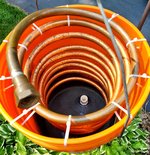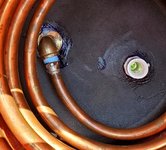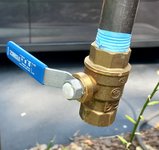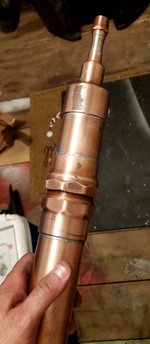A. Gorilla
Omono
Decent auto paint is too expensive to go cheap on the odds and ends like tape or air filters.
Having exhausted all off-the-shelf solutions with reasonable price tags, I concluded my less-than-stellar clear coat texture was moisture related.
Onto the mission of wringing out maximum efficiency in use of space and money while aiming at superlative results which will last 1,000 years.
Step 1. Understand what fundamentally makes water vapor exit the air with respect to pressure and temperature. Compression, chilling (also compression basically), and adsorption into a media.
So, what kind of filter removes air with pressure? I.e. how do you recreate a storm front in a closed system?
Bernoulli's principle. High velocity air is low pressure. Low velocity air is high pressure. The interface of both results in condensation...the kind you'd see downstream on the edge of an airplane wing.
How to make that? A small diameter pipe feeding a rapidly expanded diameter pipe. Much like the air compressor tank itself and why it needs draining.
Much like how the off-the-shelf water traps work, EXCEPT, "big filter" would have you believe it is their important little filter element doing the work. Mostly false.
So, enter my first stage of filtration. Narrow pipe expanding to wide, back to narrow. Water pours out of this in just a few inches of length. It's awesome. No filter media.
Secondly, how to cool air. Using water is a no brainer. It conducts heat 23x faster than air. I copied some youtube guy and surbmerged coil in a fillable bucket. Ice would amplify the process. If my reckoning is correct every foot of air cooled pipe is worth 23 feet of submerged pipe? It's probably not that linear of a relationship, but still...
Finally, "big filter" has very expensive large dessicant filters. The small ones are useless for larger jobs. Enter the 2" copper pipe which is fillable with silica or whatever.
I will probably cave and conclude this with a factory particle filter.
So that's that, and I don't have to devote a wall to miles of copper pipe and "catch drops" with a million ball valves.
Having exhausted all off-the-shelf solutions with reasonable price tags, I concluded my less-than-stellar clear coat texture was moisture related.
Onto the mission of wringing out maximum efficiency in use of space and money while aiming at superlative results which will last 1,000 years.
Step 1. Understand what fundamentally makes water vapor exit the air with respect to pressure and temperature. Compression, chilling (also compression basically), and adsorption into a media.
So, what kind of filter removes air with pressure? I.e. how do you recreate a storm front in a closed system?
Bernoulli's principle. High velocity air is low pressure. Low velocity air is high pressure. The interface of both results in condensation...the kind you'd see downstream on the edge of an airplane wing.
How to make that? A small diameter pipe feeding a rapidly expanded diameter pipe. Much like the air compressor tank itself and why it needs draining.
Much like how the off-the-shelf water traps work, EXCEPT, "big filter" would have you believe it is their important little filter element doing the work. Mostly false.
So, enter my first stage of filtration. Narrow pipe expanding to wide, back to narrow. Water pours out of this in just a few inches of length. It's awesome. No filter media.
Secondly, how to cool air. Using water is a no brainer. It conducts heat 23x faster than air. I copied some youtube guy and surbmerged coil in a fillable bucket. Ice would amplify the process. If my reckoning is correct every foot of air cooled pipe is worth 23 feet of submerged pipe? It's probably not that linear of a relationship, but still...
Finally, "big filter" has very expensive large dessicant filters. The small ones are useless for larger jobs. Enter the 2" copper pipe which is fillable with silica or whatever.
I will probably cave and conclude this with a factory particle filter.
So that's that, and I don't have to devote a wall to miles of copper pipe and "catch drops" with a million ball valves.
Attachments
-
 20230822_144356.jpg288.3 KB · Views: 6
20230822_144356.jpg288.3 KB · Views: 6 -
 20230822_144403.jpg269.6 KB · Views: 6
20230822_144403.jpg269.6 KB · Views: 6 -
 20230822_144417.jpg201.4 KB · Views: 5
20230822_144417.jpg201.4 KB · Views: 5 -
 20230822_144421.jpg175.2 KB · Views: 5
20230822_144421.jpg175.2 KB · Views: 5 -
 20230822_144026.jpg376.1 KB · Views: 5
20230822_144026.jpg376.1 KB · Views: 5 -
 20230820_200431.jpg77.1 KB · Views: 5
20230820_200431.jpg77.1 KB · Views: 5 -
 20230820_200418.jpg69.2 KB · Views: 5
20230820_200418.jpg69.2 KB · Views: 5 -
 20230822_174301.jpg238.5 KB · Views: 6
20230822_174301.jpg238.5 KB · Views: 6
